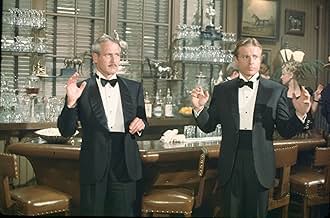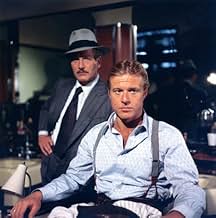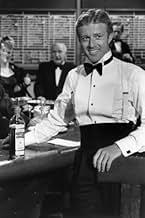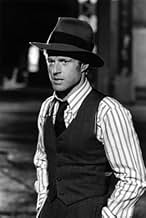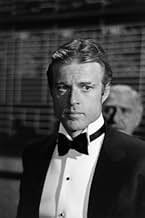Deux escrocs font équipe pour réaliser l'arnaque du siècle.Deux escrocs font équipe pour réaliser l'arnaque du siècle.Deux escrocs font équipe pour réaliser l'arnaque du siècle.
- Récompensé par 7 Oscars
- 18 victoires et 6 nominations au total
Robert Earl Jones
- Luther Coleman
- (as Robertearl Jones)
James Sloyan
- Mottola
- (as James J. Sloyan)
Best Picture Winners by Year
Best Picture Winners by Year
See the complete list of Best Picture winners. For fun, use the "sort order" function to rank by IMDb rating and other criteria.
Histoire
Le saviez-vous
- AnecdotesGeorge Roy Hill used some 1930s stylistic techniques. The film starts with a 1930s-era Universal logo, and used editing wipes to transition between scenes and iris shots.
- GaffesIn the bathroom, Hooker can be seen saying, "He didn't tell me you was a fuck-up either." This has been looped to replace it with the less profane "He didn't tell me you was a screw-up either." (The grammar error is scripted.)
- Citations
Johnny Hooker: Can you get a mob together?
Henry Gondorff: After what happened to Luther, I don't think I can get more than two, three hundred guys.
- Crédits fousThe opening animated logo for Universal Pictures is in 1930s style, matching the movie's setting, instead of the 1970s version.
- ConnexionsFeatured in Oscars, Actors and The Exorcist (1974)
Commentaire à la une
The Sting.
The Sting (1973) is one of everybody's favorite films. Director George Roy Hill took a page from his successful western, Butch Cassidy and the Sundance Kid, and teamed Paul Newman and Robert Redford once again, this time for an Academy Award four star movie about con men.
The intricate saga of The Sting is set in 1936 Chicago. It tells the story of grifters, Henry Gondorff and Johnny Hooker, played by Paul Newman and Robert Redford, respectively. They con the bad guy, Doyle Lonnegan, played by Robert Shaw. And at every turn, they con the audience as well.
The poker game is five card draw ('straight poker' in the film) and is set on a train traveling from New York to Chicago. Newman and Redford are on the train along with Shaw. The game has been set up by Shaw with the cooperation of the conductor. We don't know how Newman and Redford know exactly what day and what train Shaw is taking from New York to Chicago, but that is beside the purpose of our discussion. Shaw is a known card cheater, but Newman will prove to be a better one. Once again the holy game of poker will be sullied by the movies. This time, we'll love every minute of it.
Newman arranges to get himself invited to the poker game, through the conductor. He arrives sober, but apparently inebriated. It is the perfect act, consummately played in a boozy, needling performance by Paul Newman.
Shaw's character is a known cold decker (a 'cold deck' is a deck introduced surreptitiously into the game with hands pre-arranged to break one of the players)' and Newman will have to play over the top of the cold deck when it is placed into the game.
One of the subtleties of the event is missed by most viewers. Newman must ready himself to overcome the cold deck. During the play of hands, we see Newman hold the cards close to his vest and, at least once, his cards disappear briefly below table level, out of sight, and back again. Newman knows Shaw cold decks middle cards against low cards, and so Newman is gathering and holding out jacks.
Newman immediately insults Shaw upon arrival and continues to heckle him throughout the play of the game, thus making sure Shaw will cold deck the game to teach the upstart drunk a lesson. When Shaw goes to the men's room to arrange to fix the cold deck, Newman knows the time has come. (In real life, cold decks were nearly always arranged in men's rooms. They should have had a dedicated stall marked 'coolers made here'.)
The game is three handed at this point. Shaw will bring the cold deck in when he cuts the cards for the dealer to his left. In filming the cold decking, the camera shows a pair of hands over the deck, then there's a cut in the continuity. Then the camera goes immediately back to the deck and we see the hands with the warm deck going to a handkerchief in Shaw's lap, leaving the cold deck on the table. I guess it would have been hard to do in one long shot.
The detail is interesting during the dealing of the cold deck. Newman is fussing with his cigar and poking behind his vest, implying something is happening. But we never see Newman with hand positions that could be holding out cards.
Newman is dealt trip threes and Shaw is dealt a pair of nines. The third player is the dealer and he is out of the hand. Newman draws two cards and gets his four threes with the six of hearts. Shaw draws three cards and gets his four nines with the ten of spades.
The planning of the arranged cold deck is well done and probable. After the cards are dealt, the cards on top of the deck are, in order, a three, the six of hearts, two nines and the ten of spades. It doesn't matter whether Newman draws one or two cards, he'll make his four threes and, in either case, Shaw, in drawing three cards, will make his four nines.
Now, here's the unlikely trick. Newman must change the hand with four threes for a hand with four jacks. It would be easiest to hold out an entire hand of four jacks and a fifth card and switch five card hands. But Newman switches only the four threes for the four jacks he's held out and he keeps the six of hearts. That is much harder to do and less likely would be the method chosen. Newman also takes the chance that Shaw won't have one of the legitimate jacks in his hand with the four nines, but in having to play over the top of the cold deck, that gamble is unavoidable.
Shaw's problem is that he can't call Newman for card manipulation because Shaw has an audience, the other players and the conductor. After Newman leaves the cabin, Shaw says to his lackey, 'What was I supposed to do? Call him for cheating better than me, in front of the others?'
Shaw was able to get $10,000 more in chips during a hand in a table stakes game. But that was okay with Newman.
The film shows Shaw wiping his face with a handkerchief during the play of the hand, implying he has disposed of the warm deck. However, we never see Newman clean up. So, when he leaves the poker cabin, one deck is short four jacks, the other deck has four extra jacks, and Newman still has four threes behind his vest somewhere. Whoever the conductor gives the decks to next, will have a few surprises.
Despite its faults, the poker scene from The Sting is the most fun filled, greatest directed, best acted, and most involved offering in cheating poker film history. And it was made over thirty years ago.
Silver Dollar Sam NothingWild.com
The Sting (1973) is one of everybody's favorite films. Director George Roy Hill took a page from his successful western, Butch Cassidy and the Sundance Kid, and teamed Paul Newman and Robert Redford once again, this time for an Academy Award four star movie about con men.
The intricate saga of The Sting is set in 1936 Chicago. It tells the story of grifters, Henry Gondorff and Johnny Hooker, played by Paul Newman and Robert Redford, respectively. They con the bad guy, Doyle Lonnegan, played by Robert Shaw. And at every turn, they con the audience as well.
The poker game is five card draw ('straight poker' in the film) and is set on a train traveling from New York to Chicago. Newman and Redford are on the train along with Shaw. The game has been set up by Shaw with the cooperation of the conductor. We don't know how Newman and Redford know exactly what day and what train Shaw is taking from New York to Chicago, but that is beside the purpose of our discussion. Shaw is a known card cheater, but Newman will prove to be a better one. Once again the holy game of poker will be sullied by the movies. This time, we'll love every minute of it.
Newman arranges to get himself invited to the poker game, through the conductor. He arrives sober, but apparently inebriated. It is the perfect act, consummately played in a boozy, needling performance by Paul Newman.
Shaw's character is a known cold decker (a 'cold deck' is a deck introduced surreptitiously into the game with hands pre-arranged to break one of the players)' and Newman will have to play over the top of the cold deck when it is placed into the game.
One of the subtleties of the event is missed by most viewers. Newman must ready himself to overcome the cold deck. During the play of hands, we see Newman hold the cards close to his vest and, at least once, his cards disappear briefly below table level, out of sight, and back again. Newman knows Shaw cold decks middle cards against low cards, and so Newman is gathering and holding out jacks.
Newman immediately insults Shaw upon arrival and continues to heckle him throughout the play of the game, thus making sure Shaw will cold deck the game to teach the upstart drunk a lesson. When Shaw goes to the men's room to arrange to fix the cold deck, Newman knows the time has come. (In real life, cold decks were nearly always arranged in men's rooms. They should have had a dedicated stall marked 'coolers made here'.)
The game is three handed at this point. Shaw will bring the cold deck in when he cuts the cards for the dealer to his left. In filming the cold decking, the camera shows a pair of hands over the deck, then there's a cut in the continuity. Then the camera goes immediately back to the deck and we see the hands with the warm deck going to a handkerchief in Shaw's lap, leaving the cold deck on the table. I guess it would have been hard to do in one long shot.
The detail is interesting during the dealing of the cold deck. Newman is fussing with his cigar and poking behind his vest, implying something is happening. But we never see Newman with hand positions that could be holding out cards.
Newman is dealt trip threes and Shaw is dealt a pair of nines. The third player is the dealer and he is out of the hand. Newman draws two cards and gets his four threes with the six of hearts. Shaw draws three cards and gets his four nines with the ten of spades.
The planning of the arranged cold deck is well done and probable. After the cards are dealt, the cards on top of the deck are, in order, a three, the six of hearts, two nines and the ten of spades. It doesn't matter whether Newman draws one or two cards, he'll make his four threes and, in either case, Shaw, in drawing three cards, will make his four nines.
Now, here's the unlikely trick. Newman must change the hand with four threes for a hand with four jacks. It would be easiest to hold out an entire hand of four jacks and a fifth card and switch five card hands. But Newman switches only the four threes for the four jacks he's held out and he keeps the six of hearts. That is much harder to do and less likely would be the method chosen. Newman also takes the chance that Shaw won't have one of the legitimate jacks in his hand with the four nines, but in having to play over the top of the cold deck, that gamble is unavoidable.
Shaw's problem is that he can't call Newman for card manipulation because Shaw has an audience, the other players and the conductor. After Newman leaves the cabin, Shaw says to his lackey, 'What was I supposed to do? Call him for cheating better than me, in front of the others?'
Shaw was able to get $10,000 more in chips during a hand in a table stakes game. But that was okay with Newman.
The film shows Shaw wiping his face with a handkerchief during the play of the hand, implying he has disposed of the warm deck. However, we never see Newman clean up. So, when he leaves the poker cabin, one deck is short four jacks, the other deck has four extra jacks, and Newman still has four threes behind his vest somewhere. Whoever the conductor gives the decks to next, will have a few surprises.
Despite its faults, the poker scene from The Sting is the most fun filled, greatest directed, best acted, and most involved offering in cheating poker film history. And it was made over thirty years ago.
Silver Dollar Sam NothingWild.com
- SilverDSam
- 25 oct. 2004
- Permalien
Meilleurs choix
Connectez-vous pour évaluer et suivre la liste de favoris afin de recevoir des recommandations personnalisées
Détails
Box-office
- Budget
- 5 500 000 $US (estimé)
- Montant brut aux États-Unis et au Canada
- 156 000 000 $US
- Montant brut mondial
- 156 000 000 $US
- Durée2 heures 9 minutes
- Couleur
- Rapport de forme
- 1.85 : 1
Contribuer à cette page
Suggérer une modification ou ajouter du contenu manquant





